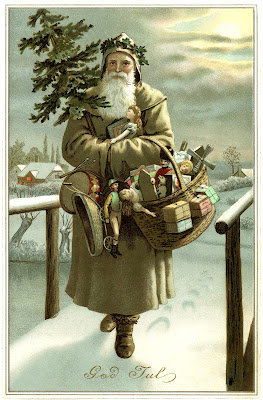The methods of Claus, the Great and Powerful are universally known, told, quite literally, in song and story. (Much of the established canon comes from one particular poem, in fact, making it both a song and a story.) Long before the Elf/Shelf Surveillance Network was set up, we were assured that Santa simply knew if we were "bad" or "good," and admonished to be the latter if we had any hope of receiving the presents we were expecting. The punitive lump of coal is an interesting holdover from an era when the stuff was commonplace - but it persisted long after most children had ever seen a lump of coal, let alone had to help carry it or feed it into home furnace (there also being an implication of punishment and drudgery for those benighted children unfortunate enough to find themselves part of an anthracite yuletide). But... you never actually hear about those, do you? That's a side of St. Nicholas rarely seen. Some regional traditions pass these duties off to a magical assistant like the Krampus, but in Krampus-light societies like our own, Santa's role as cruel arbiter is downplayed. Unnecessary. Which is, I think, vital to why he, as an embodiment of story, remains vital to us... even (especially?) if we're long past the age where we can "believe" in him as a literal, incarnate figure.
As a society, we're taught to engage with "belief" in some funny ways, aren't we? In religious communities and families associated with them, continued "belief" in a higher power is a sign of maturity, particularly once has begun to endure the hardships of adult life. And yes, a similar "belief" in Santa Claus must be shattered to enter adulthood. Not that there's a default approach to "belief" that applies to every group, in every situation, or even that it means the same things at all times: sometimes it refers to blind acceptance of what one's been taught, sometimes to self-confidence, sometimes as an affirmative, if noncommittal response (at least... I believe this to the case). And so, with such a wide range of what the word (and even concept) means, I'd like to suggest a re-appraisal of our "belief" in that kindly old elf, the Master of Reindeer... Santa Claus.
For our last holiday post, I discussed the role of story in the celebration of our recurring traditions, and in particular some of the baggage they carry and harms they can cause. So I'd like this to serve as something of a followup, a response looking at another story, one less loaded and, indeed, flexible enough to meet the needs of many rather than enforcing a particular status quo. We've all seen pictures of Santa as different ethnicities, and even the gender of our holiday patron is open to discussion. Regardless of advertising so ubiquitous that people might think otherwise, Coca-Cola does not own Santa Claus or the popular image of him. Indeed when finding pictures for this post, I found myself reacting to images of Santa more when he was in colors other than red - suddenly he was the figure of myth and story again, rather than a marketing device or simplified iconography to represent anything associated with the secular aspects of the holiday.
A mythical figure, now that's something to engage with. Not a lie to outgrow, as the modern relationship with Santa demands, but a story. What does it mean to believe in a story? That there's something of value there, a reflection of aspects of our own lives or values we'd like to embody and live up to. And, free of the trappings of religious affiliation, Santa (sans Krampus) is one of the best we could believe in. Not the judge, but the unifier, bringing gifts to all the children, of all ages. And if he's not doing that on this earth (although NORAD has to be picking something up, right?) we do it in his stead. Not because people have been bad or good, there's plenty of recourse for those things elsewhere, but simply because they're people.So, I'm happy to say I believe in Santa Claus, just as I believe in the power of stories, in the people that tell them, and the people that listen. That's why I'm able to do this, it's why I'm able to do a lot of things, and if you're reading this, that's probably the case for you, too. As 2023 draws to a close, we at Never Say Dice are honored to share our stories with you, regardless of who you imagine is coming down your chimney, or driving a sleigh across the glittering night.
Send questions, comments, and holiday cheer to neversaydice20@gmail.com or Tweet us @neversaydice2 (we're not going to let Elon Musk steal the X from X-Mas).



